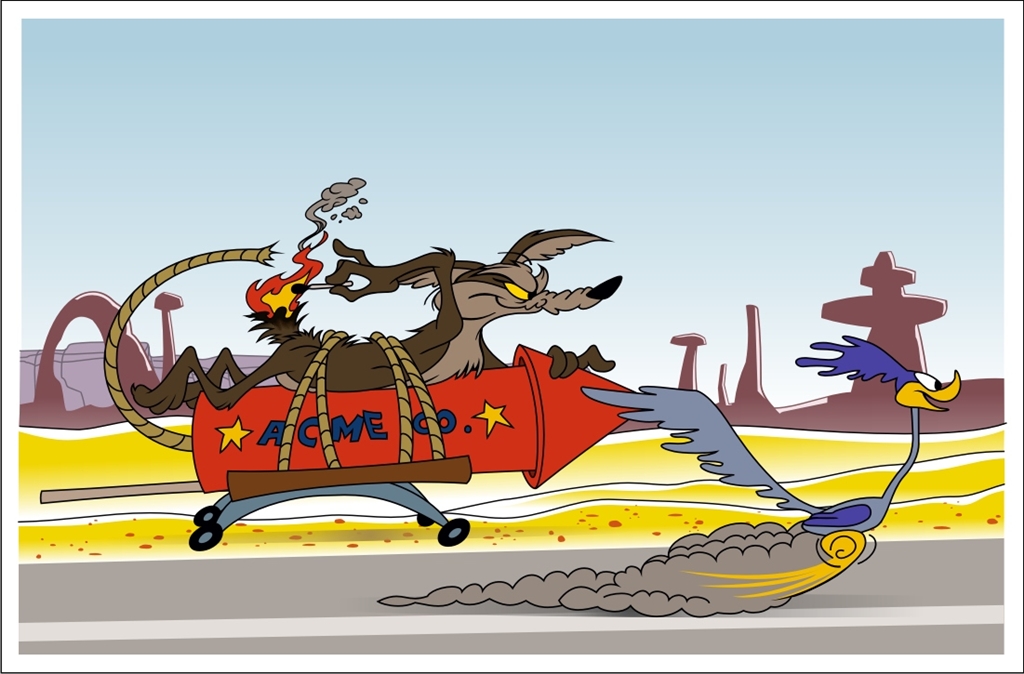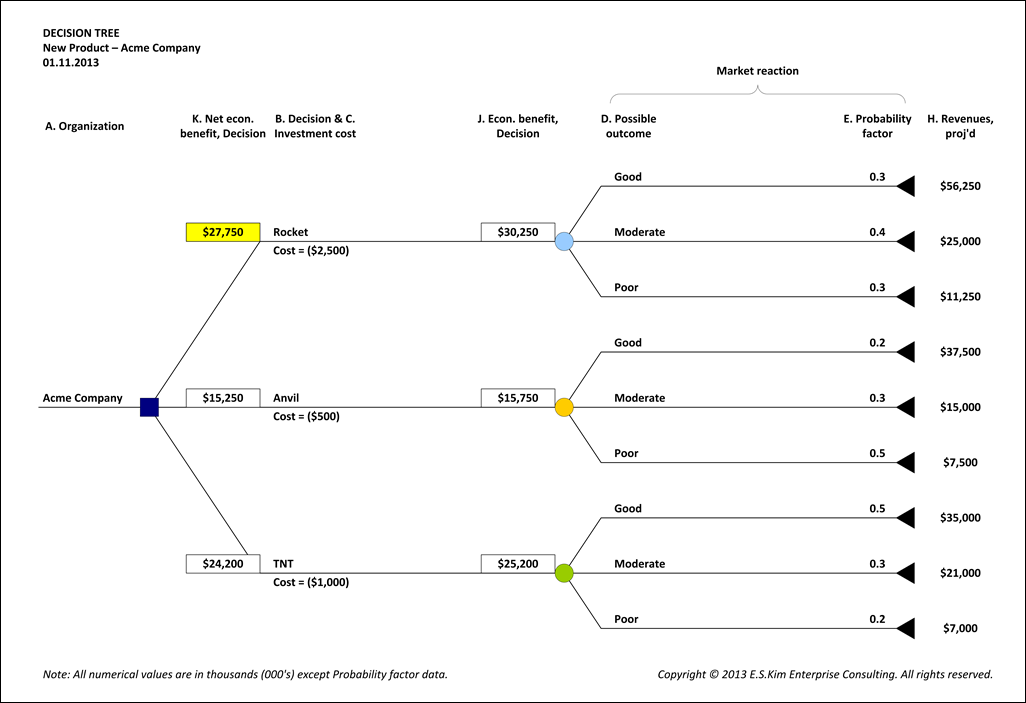Big Decisions Require a Decision Tree

A Tool for Big Decisions
When you first started up your business, you may have made many of your initial decisions by gut instinct. At this level, perhaps your intuition worked out for you more often than not. After your business began to grow and you added staff, you may have made decisions by committee, which provides a greater level of objectivity and assurance to the decision-making process.
However, when your business scales up beyond a certain level (and especially if you have stakeholders involved who have a vested interest in the direction of your business), you’ll want to employ a more objective, analytical decision-making methodology to make major decisions. A tool that larger, savvier organizations use is a Decision Tree and the process is called Decision Tree Analysis.
Relationship to Business Strategy
A decision tree analysis is a management tool used to analyze the economic viability of multiple courses of action among which an organization can choose at a particular juncture in time. It’s commonly used in situations involving capital investment decisions such as when an organization wants to add a new product to its portfolio or another line of business. As such, decision tree analysis can help management employ an objective, analytical process to make the best decision among multiple capital investment options by determining the net economic benefit of each option.
So how does a decision tree analysis relate to business strategy, you ask? Well, if Acme Company, a producer and distributor of large boulders to the predatory hunting market, is interested in expanding its product line as part of a business growth strategy, a decision tree analysis can help Acme management determine the best product to add to the portfolio.
Perhaps Acme has received feedback from its very important coyote customer segment that the boulder just doesn’t seem to work as well these days in slowing down road runners as it once did. In response, Acme is considering adding a rocket, anvil, or TNT to its product portfolio. A decision tree analysis will help Acme management decide whether the rocket, anvil, or TNT is the best option.
The Key Elements
In general, the key elements of a decision tree analysis are listed below. You can add additional elements or provide supporting elements in your decision tree model depending on the complexity of your decision or to provide a greater degree of granularity in the information you want to present.
- Decision. The array of courses of action the organization is considering. The decisions should be those over which the organization has control and mutually exclusive of one another.
- Investments cost. The sum of all costs the organization expects to incur in the process of pursuing a course of action. In the case of new product development and launch, this can include R&D, design, production, marketing, labor, and other costs associated with taking the product to market.
- Possible outcomes. The array of possible outcomes that can result for each decision. These are results – often the market reaction to a decision – over which the organization has no control.
- Probability factor. The likelihood of occurrence – expressed as a percentage or fraction – of a possible outcome for a given decision. All possible outcomes for each decision should add up to 100% or 1.0.
- Outcome value. The estimated economic value of a possible outcome. For most applications of the decision tree, this is a quantitative figure representing the financial return anticipated for a given outcome (e.g., revenues or cash flow).
- Economic benefit. The estimated economic benefit for a given decision incorporating all possible outcomes and the likelihood of occurrence of each outcome.
- Net economic benefit. The estimated net economic benefit for a given decision. This is the economic benefit of each decision over investment cost and is the determining factor upon which the decision should be made.
Decision Tree Applied
In Acme’s case, it’s deciding among the rocket, anvil, and TNT for a new product development and launch decision. I first build the framework for the decision tree analysis using MS Excel. A new product decision tree model for Acme Company would look like the following:
 Click on the thumbnail to see the image in its full size.
Click on the thumbnail to see the image in its full size.
The elements of Acme’s new product decision tree model are as follows:
A. Organization. Acme Company.
B. Decision. Acme is considering a new product development and launch among the rocket, anvil, and TNT.
C. Investment cost. The total cost Acme expects to incur in the process of sourcing, producing, and taking each product to market. This cost is the sum of all marginal R&D, production, marketing, labor, and other costs associated with taking the product to market.
D. Possible outcome. The array of possible outcomes that can result for each course of action. Acme can’t be sure how coyotes will receive the new product, so it anticipates a three-level market reaction scenario of Good, Moderate, and Poor.
E. Probability factor. Acme has estimated the probabilities of each possible market reaction per decision. The sum of the three probabilities for each decision equals 1.0.
F. Sale price. The price at which the product will be sold.
G. Quantity sold, projected. The estimated number of units that Acme anticipates it will sell.
H. Revenues, projected. The estimated economic payoff value of an outcome. Revenues are a function of ‘Sale price’ and ‘Quantity sold, projected’.
I. Economic value, Outcome, projected. The value of each outcome for a given decision, taking into account the probability of occurrence. ‘Economic value, Outcome, projected’ is a function of ‘Probability factor’ and ‘Revenues, projected.’
J. Economic benefit, Decision. The total economic benefit expected for a given decision. ‘Economic benefit, Decision’ is the sum of all ‘Economic value, Outcome, projected’ for each decision.
K. Net economic benefit, Decision. The expected economic return over cost for a given decision. ‘Net economic benefit, Decision’is the ‘Economic benefit, Decision’ less ‘Investment cost’ for each decision.
As you can see, among the three decision options – rocket, anvil, and TNT – the rocket presents the best net economic benefit to Acme, $27,750,000. Thus, Acme should offer the rocket to the predatory hunting market.
Graphical Decision Tree
Next, I use MS Visio to illustrate the decision tree in a graphical format. In the following graphic, the square represents a decision node, a decision point for the organization over which it has control. Note: You can have one or more decision nodes on a Decision tree, depending on the complexity of the decision. For this model, I’ve developed a Decision tree with only one decision node. The circles represent outcomes nodes, points of possible market reactions to each decision. The organization has no control over outcomes. The triangles represent end nodes, termination points of each decision.
I’ve color coded the nodes to correspond to the color scheme I used on the MS Excel model. The graphical illustration of the new product decision tree for Acme Company would look like the following:
 Click on the thumbnail to see the image in its full size.
Click on the thumbnail to see the image in its full size.
Again, this graphic illustrates that the best decision for Acme would be to offer the rocket as it presents the highest net economic benefit of $27,750,000.
Whole Body Decision-Making
Although it’s important to use a more objective, analytical decision-making methodology on major decisions, I wouldn’t totally disregard the use of intuition in the decision-making process. That is, I want to emphasize the importance of whole body decision-making.
Not long ago, I teamed up with a local creative agency to bid on a fairly large, multi-year government sector marketing contract. I had discovered this contract opportunity only a few days prior to the proposal due date and we worked frenziedly leading up to the deadline to prepare a home-run proposal. As it was determined that the prospective client was seeking more of an outsourced creative team (rather than a contract marketing or business strategist) to help it develop and execute a marketing strategy, I let the creative firm take responsibility for the proposal development while I planned to provide project support on a particular segment of the contract.
I met with one of the principals of the creative firm to discuss the project approach and strategy we wanted to present on the proposal. After agreeing on the overall approach and strategy, I mentioned that something in my gut was telling me that we should also include an additional element appealing to what appeared to be the prospect team’s desire to become the economic hub of the region in which it operated. Although it wasn’t explicitly mentioned in the RFP, this was an underlying desire I had picked up in my review of the document.
The principal of the creative firm responded with:
“While emotional connections are good, the best way to win a project is to demonstrate you can take away the pain and positively impact their bottom line. In this case, they asked for specific tactics, but don’t have a strategy. Our opportunity is to demonstrate a proven track record of defining effective strategies that deliver measurable business results. There is a board involved, and the emotion is minimize their risk, mitigate their fear of failure and ‘make them look good’ which translates to business results.”
The creative agency principal was much more experienced on this type of work, so I deferred to her judgment.
A few weeks after we submitted the document, we received feedback on the prospect’s evaluation of our proposal. The creative agency principal reported that the prospect team thought our “Creative was excellent, approach and strategy were very good, and the proposal was very well done! However, the selected agency presented creative that positioned the [prospect] as the community focal point – the center of the community and that their imagery and positioning more directly aligned with the [prospect] teams perception of themselves and they felt there was a better match.”
Although we had presented a solid proposal based on the creative agency’s track record of success, had we listened to my intuition and added that additional element addressing the prospect team’s desire to be the economic center of the region, I’m confident we would’ve won the contract.
How I Can Help
For a thorough Decision Tree Analysis to help you make a key business decision, contact me to get started.
And if you liked what you read, share it with someone in your network by using the social media buttons below.